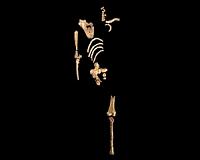| . |  |
. |
Cleveland OH (SPX) Jun 25, 2010 Meet "Lucy's" great-grandfather. Scientists from The Cleveland Museum of Natural History, Kent State University, Case Western Reserve University, Addis Ababa University and Berkeley Geochronology Center were part of an international team that discovered and analyzed a 3.6 million-year-old partial skeleton found in Ethiopia. The early hominid is 400,000 years older than the famous "Lucy" skeleton. Research on this new specimen indicates that advanced human-like, upright walking occurred much earlier than previously thought. The discovery and results from this initial analysis will be published this week in the online early edition of the Proceedings of the National Academy of Sciences. The partial skeleton belongs to "Lucy's" species, Australopithecus afarensis. It was found in the Woranso-Mille area of Ethiopia's Afar region by a team led by first author Dr. Yohannes Haile-Selassie, Curator and Head of physical anthropology at The Cleveland Museum of Natural History. The partial skeleton was excavated over five years after the discovery of a fragment of the lower arm bone in 2005. The excavation recovered the most complete clavicle and one of the most complete shoulder blades ever found in the human fossil record. The specimen was nicknamed "Kadanuumuu" (kah-dah-nuu-muu) by the authors. "Kadanuumuu" means "big man" in the Afar language and reflects its large size. The male hominid stood between 5 to 5 .5 feet tall, while "Lucy" stood at about 3 .5 feet. "This individual was fully bipedal and had the ability to walk almost like modern humans," said Haile-Selassie. "As a result of this discovery, we can now confidently say that 'Lucy' and her relatives were almost as proficient as we are walking on two legs, and that the elongation of our legs came earlier in our evolution than previously thought." Co-author Dr. C. Owen Lovejoy, Kent State University professor of anthropology, explained, "The new specimen tells us much more about the pelvis, thorax, and limb proportions than 'Lucy' was able to alone."
Share This Article With Planet Earth
Related Links Cleveland Museum of Natural History All About Human Beings and How We Got To Be Here
 3.6 million-year-old 'Lucy' relative found
3.6 million-year-old 'Lucy' relative foundCleveland (UPI) Jun 23, 2010 U.S.-led scientists say they've discovered a 3.6-million-year-old partial skeleton in Ethiopia, making it 400,000 years older than the famous "Lucy" skeleton. Scientists from The Cleveland Museum of Natural History, Kent State University, Case Western Reserve University, Ethiopia's Addis Ababa University and the Berkeley Geochronology Center said the find suggests advanced human-like, u ... read more |
|
| The content herein, unless otherwise known to be public domain, are Copyright 1995-2010 - SpaceDaily. AFP and UPI Wire Stories are copyright Agence France-Presse and United Press International. ESA Portal Reports are copyright European Space Agency. All NASA sourced material is public domain. Additional copyrights may apply in whole or part to other bona fide parties. Advertising does not imply endorsement,agreement or approval of any opinions, statements or information provided by SpaceDaily on any Web page published or hosted by SpaceDaily. Privacy Statement |